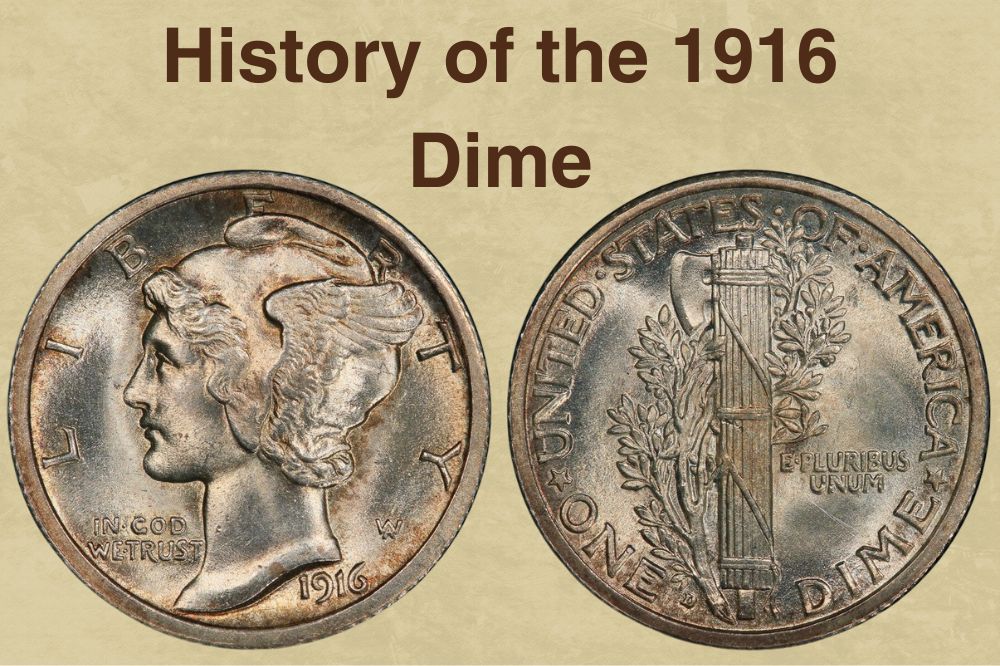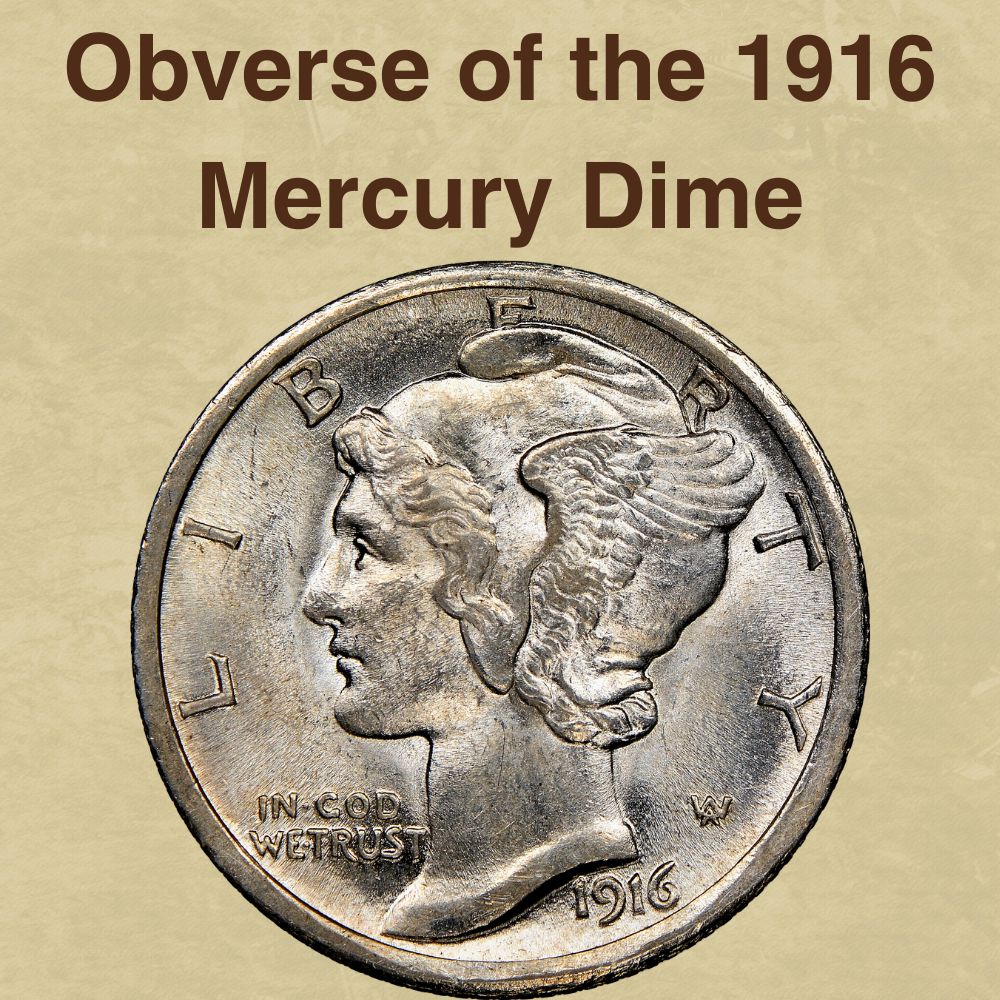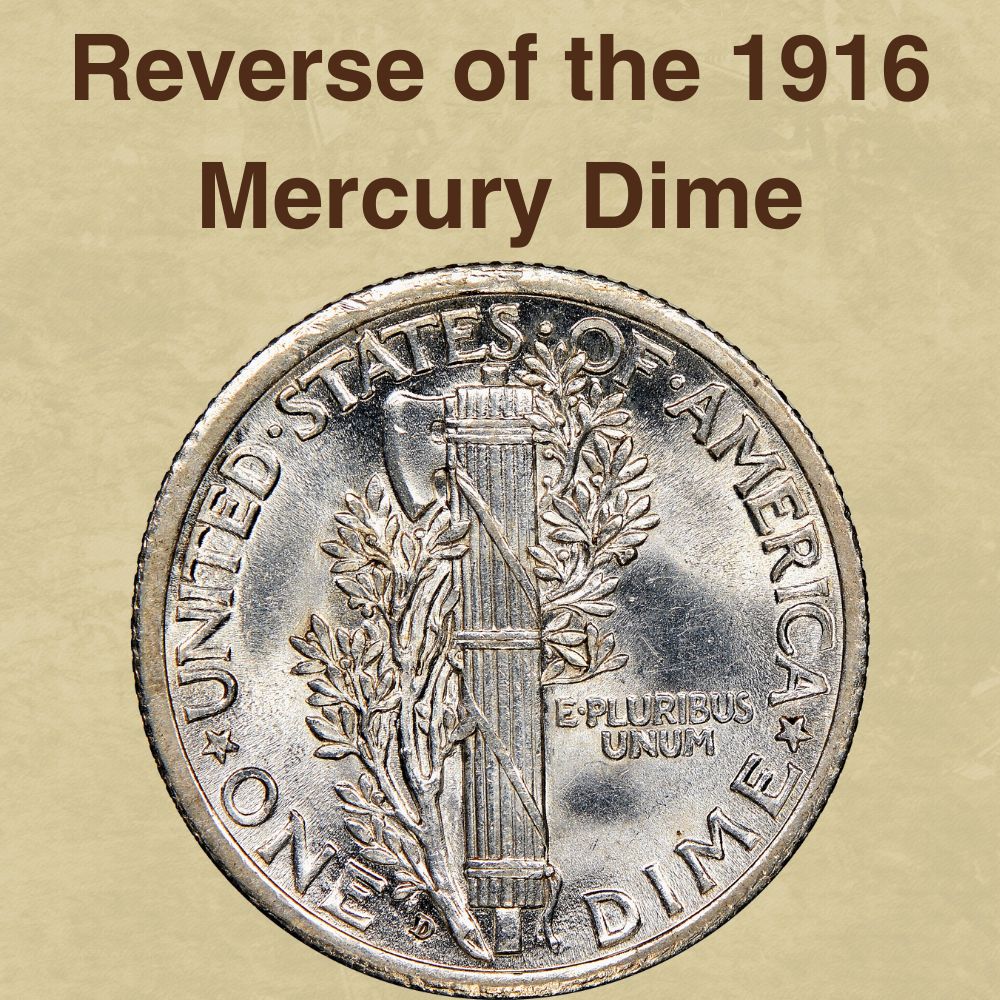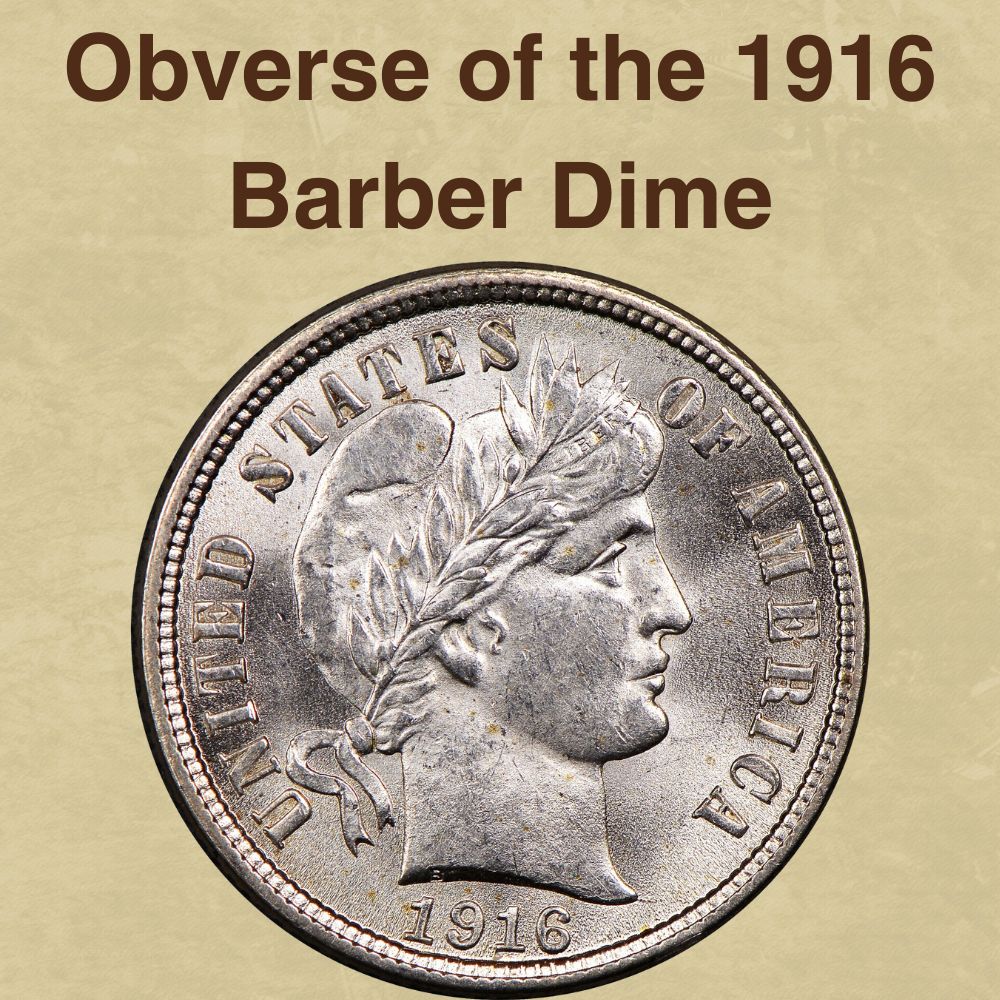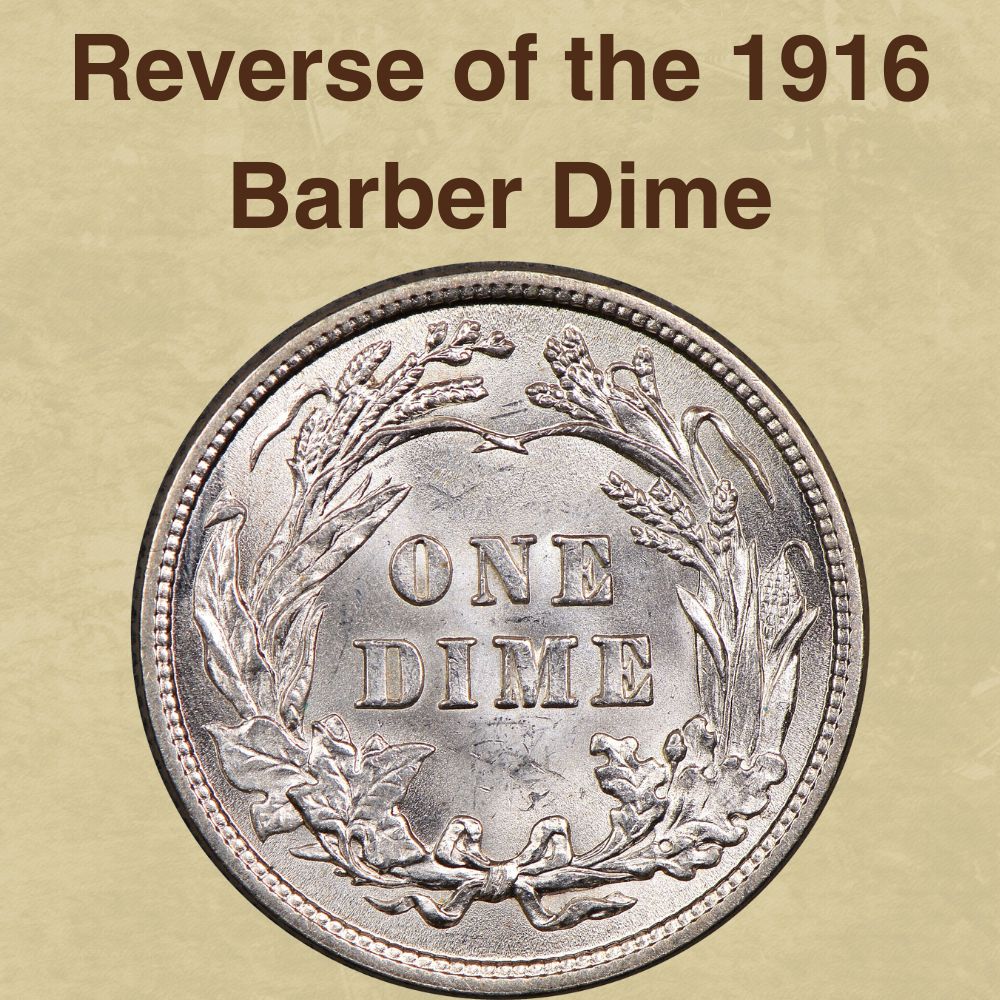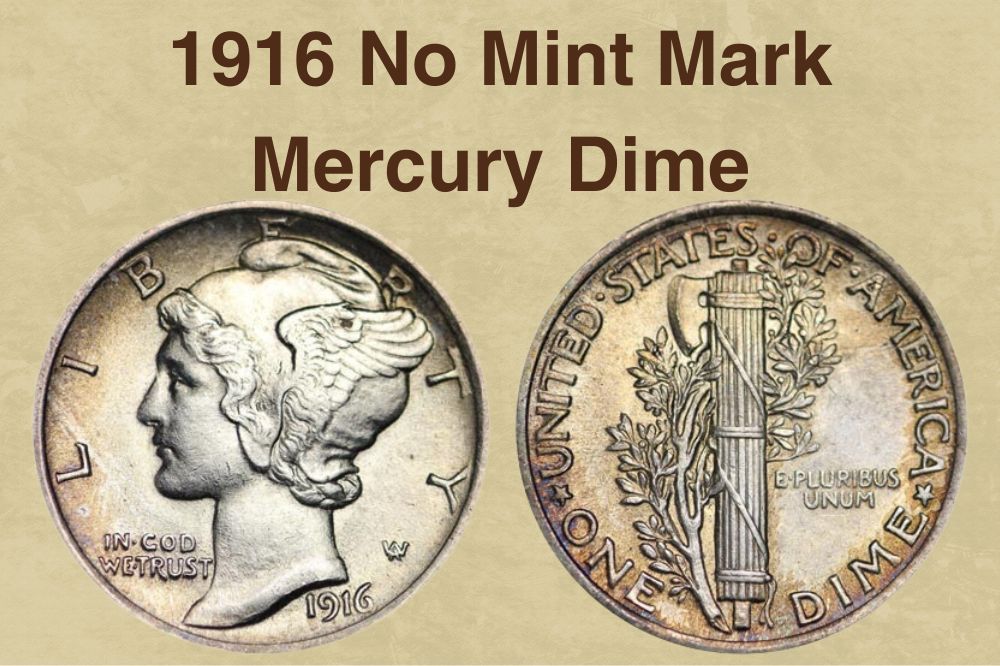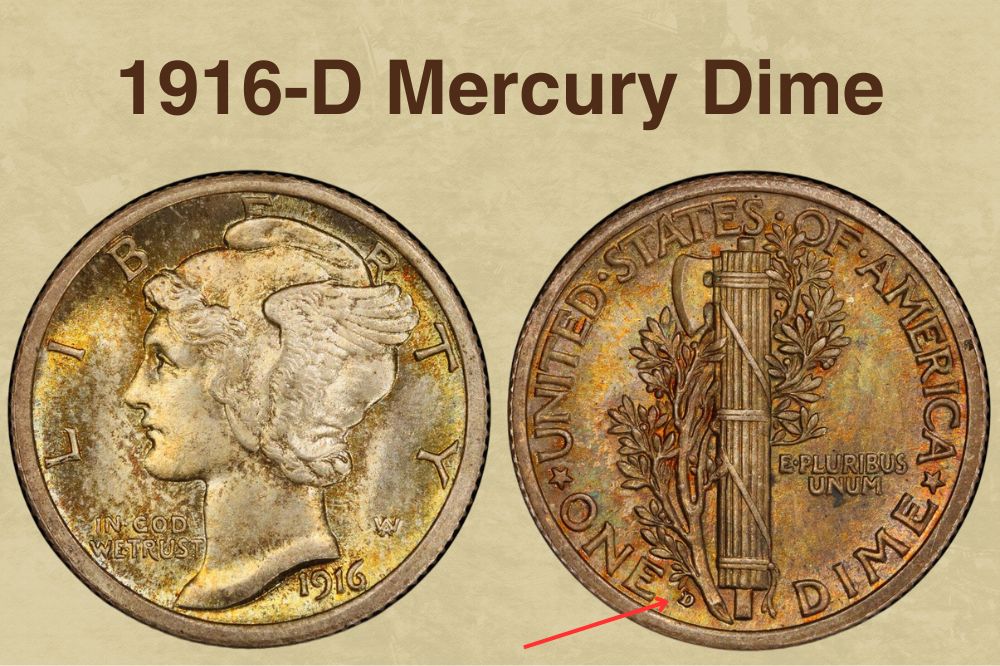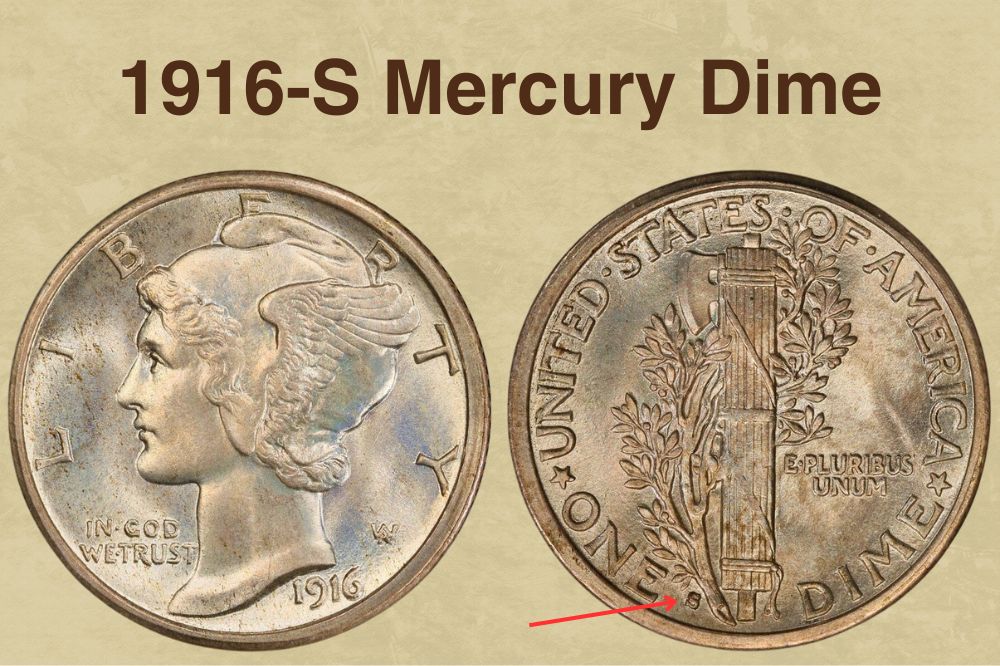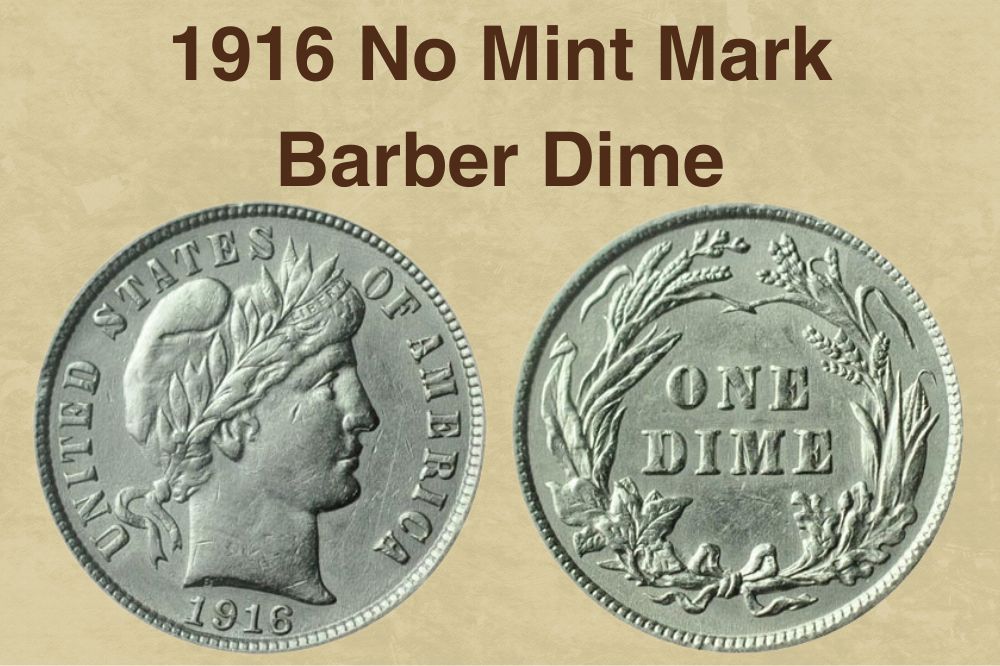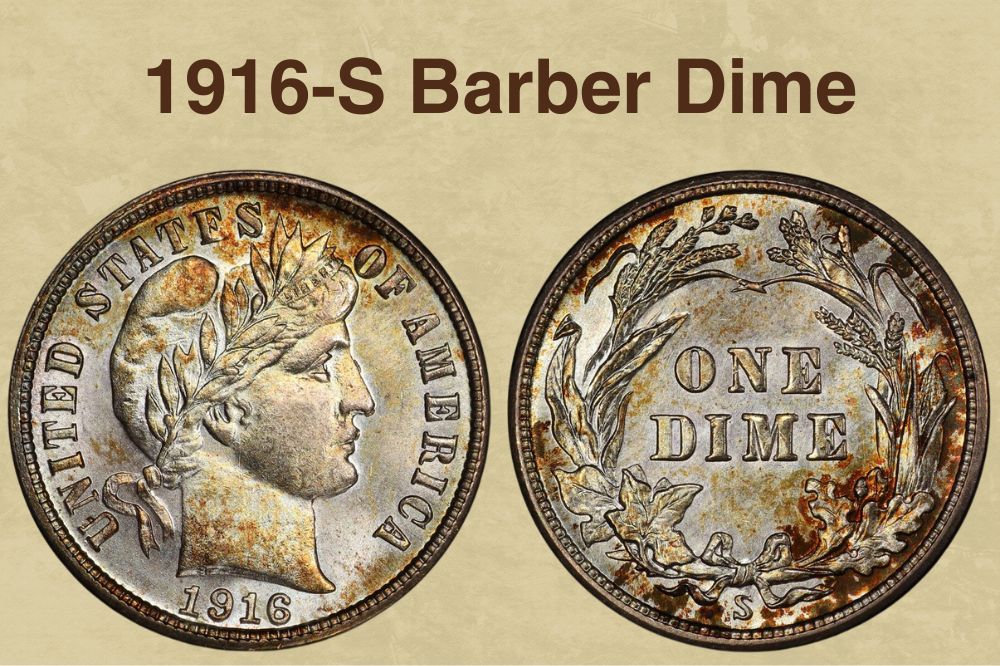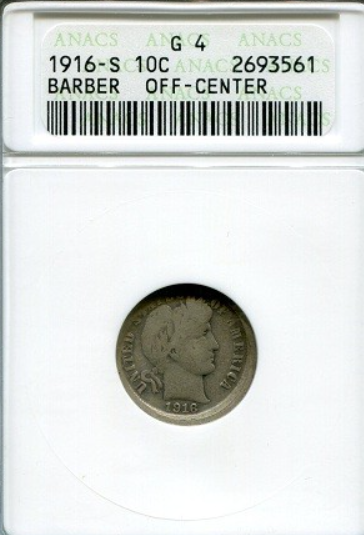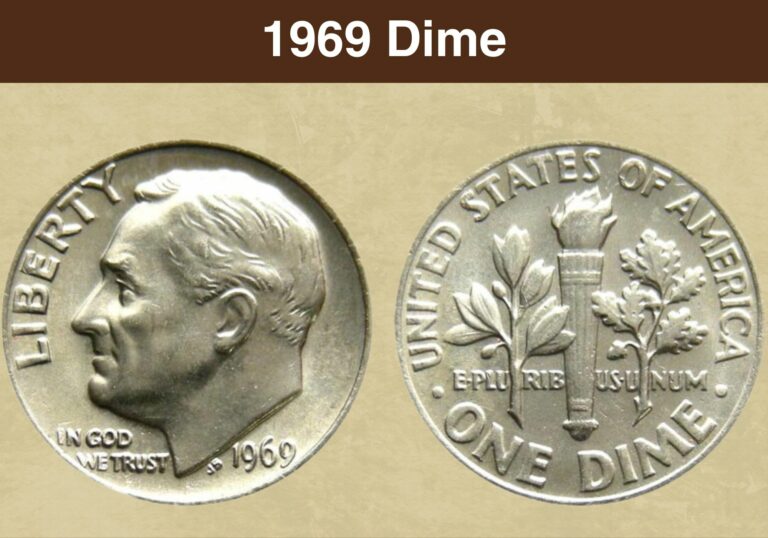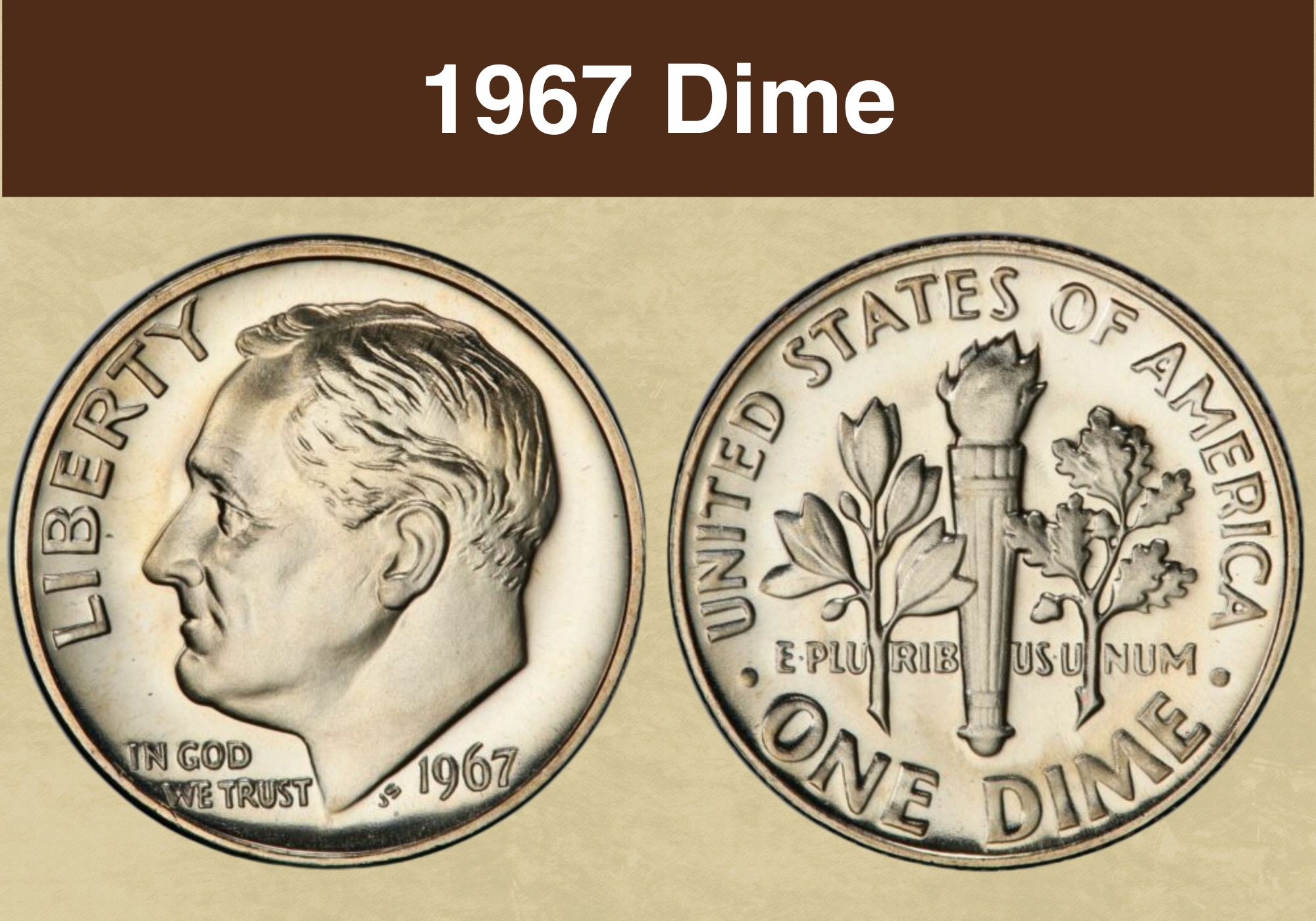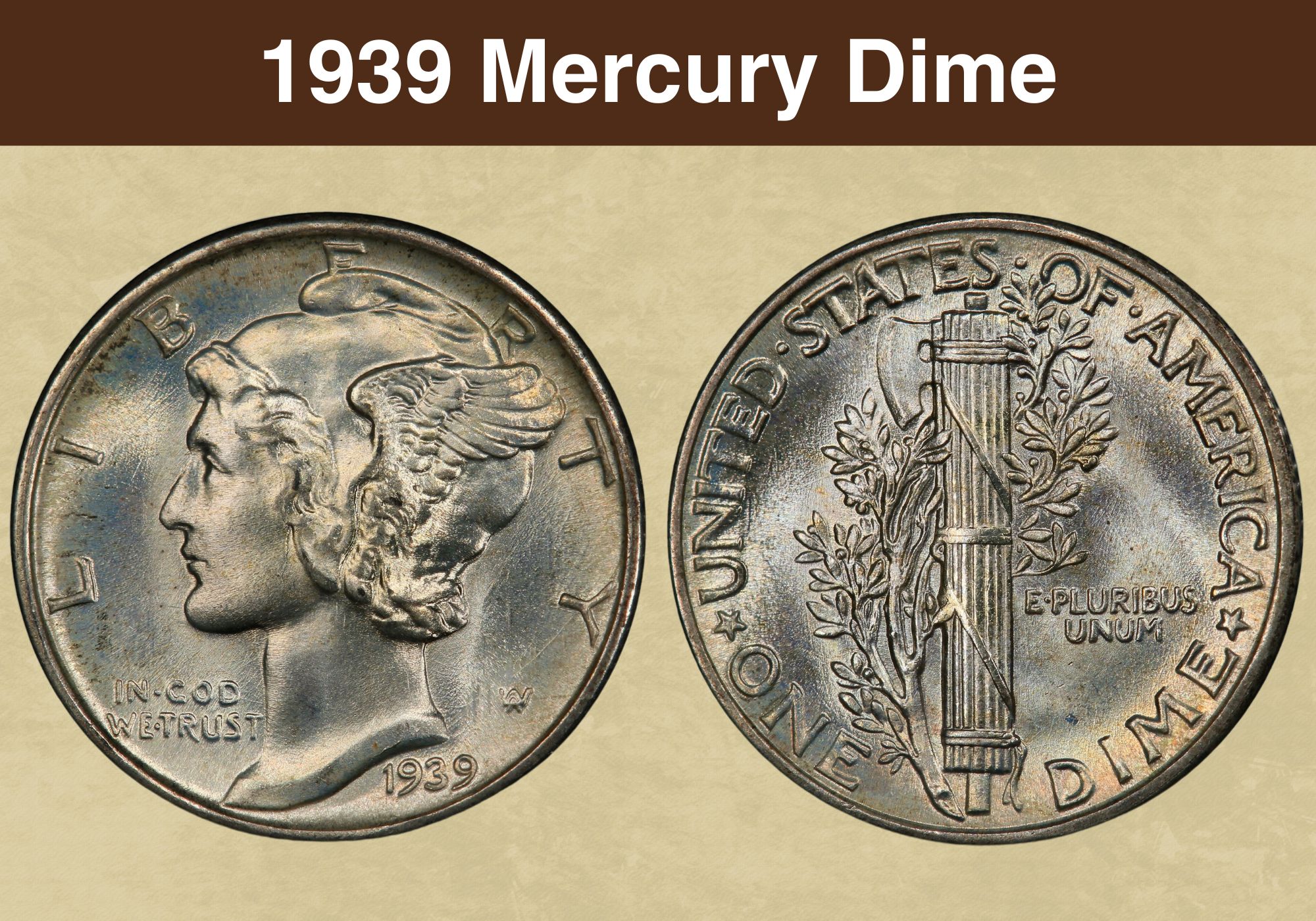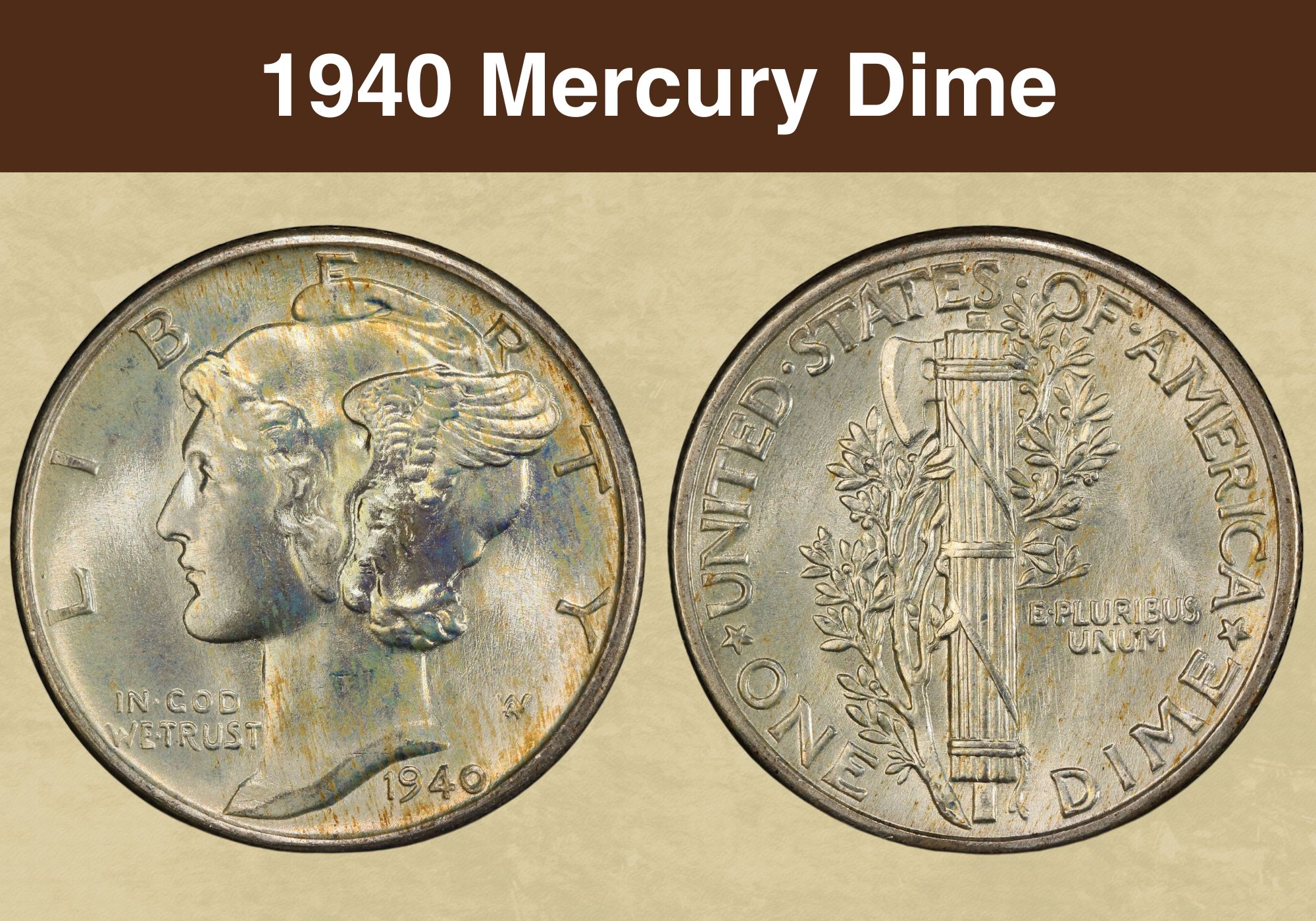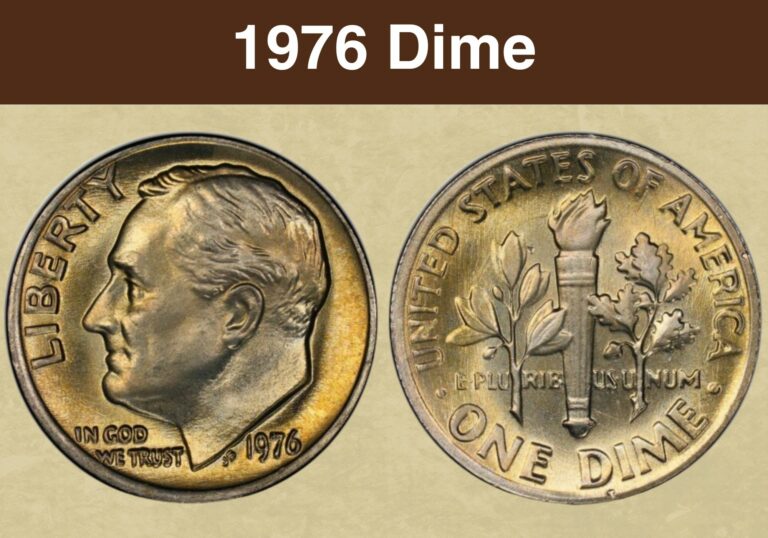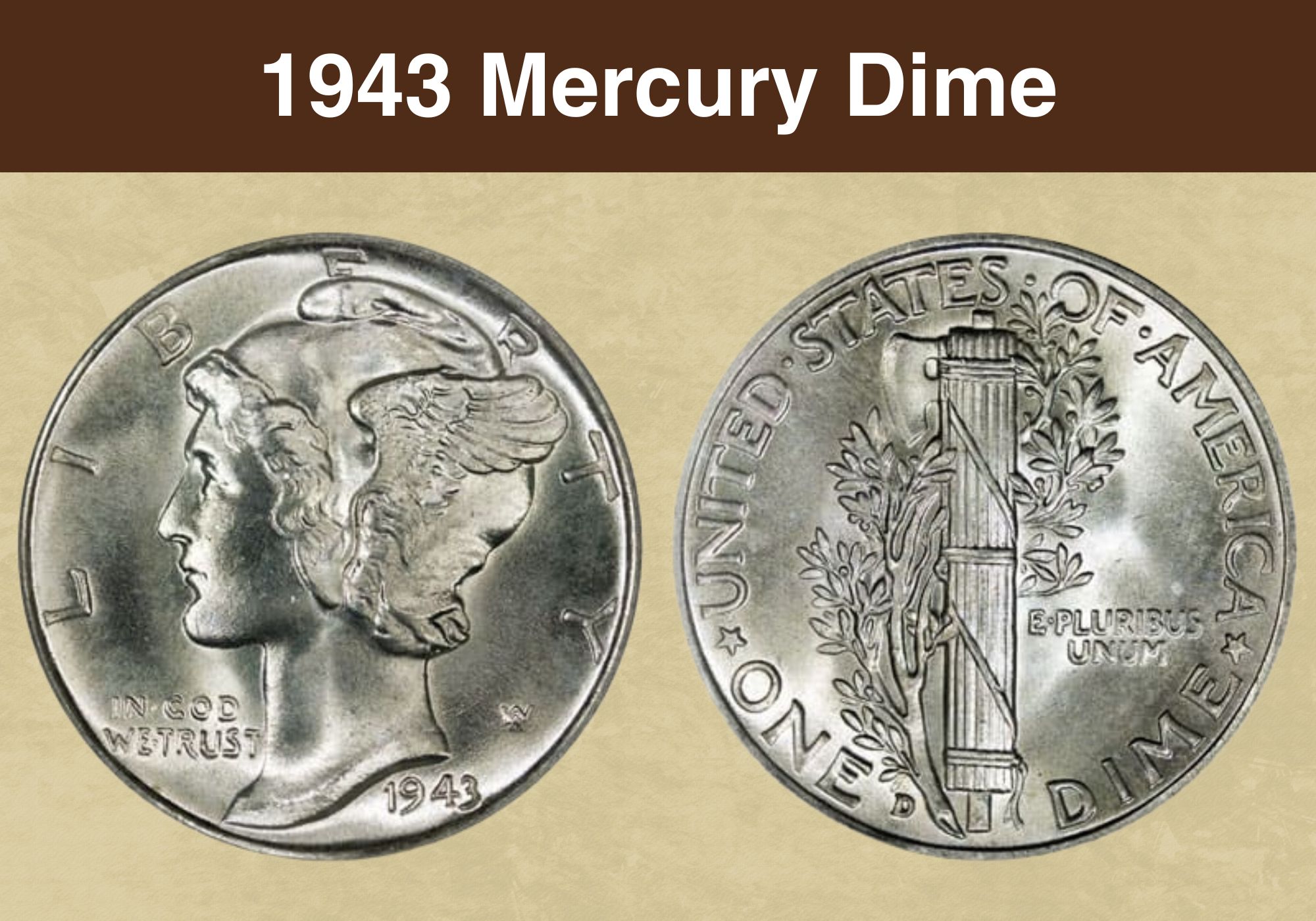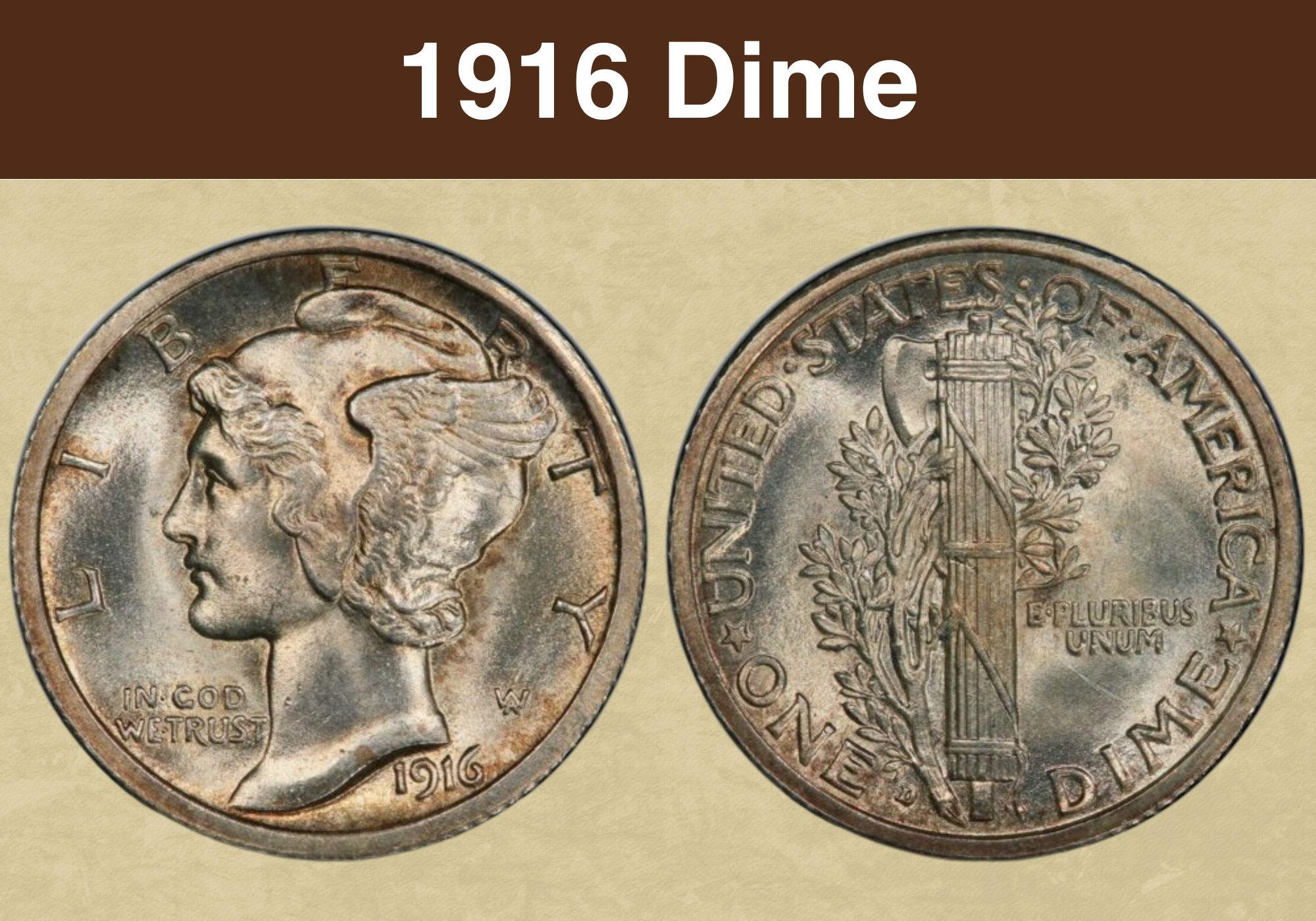
Coin Value Contents Table
- 1916 Dime Value Charts
- History of the 1916 Dime
- Features of the 1916 Dime
- 1916 Dime Grading Guides
- 1916 Dime Value Guides
- 1916 No Mint Mark Mercury Dime Value
- 1916-D Mercury Dime Value
- 1916-S Mercury Dime Value
- 1916 No Mint Mark Barber Dime Value
- 1916-S Barber Dime Value
- Rare 1916 Dime Errors List
- Where to Sell Your 1916 Dime ?
- 1916 Dime FAQ
The Dime is the nickname for American 10c coins. It comes from a word in Old French that translates as ‘tenth’ or ‘tithe’. The new 1916 Dime was a Mercury Dime. It made Lady Liberty somewhat androgynous, making people think she was a male figure – namely, a Roman god! The 1916 Barber Dime was still around as well, so let’s look at the 1916 Dime Value for both.
1916 Dime Value Charts |
||||||
| Coin | VF 25 | AU 50 | MS 60 | MS 65 | MS 67+ | MS 68+ |
| 1916 No Mint Mark Barber Dime | $27 | $75 | $210 | $465 | $4,000 | – |
| 1916-S Barber Dime | $27 | $75 | $210 | $600 | $14,000 | – |
| 1916 No Mint Mark Mercury Dime | $12 | $25 | $60 | $180 | $1,650 | – |
| 1916 No Mint Mark Mercury Dime Full Bands | – | – | $65 | $375 | $2,450 | $25,000 |
| 1916-D Mercury Dime | $5,750 | $10,250 | $15,000 | $33,500 | – | – |
| 1916-D Mercury Dime Full Bands | – | $10,500 | $18,500 | $60,000 | $285,000 | – |
| 1916-S Mercury Dime | $25 | $40 | $65 | $335 | $6,250 | – |
| 1916-S Mercury Dime Full Bands | – | – | $100 | $1,025 | $14,500 | – |
History of the 1916 Dime
In many ways, the Dime is a dividing line in US currency. On the earliest coins, anything above a dime was precious metal while the coins below dimes were base metals, with half di(s)mes shedding their silver content in 1866. Due to this, dimes and everything above them had reeds to prevent criminals from surreptitiously lowering their value by shaving off edges.
Coins under a dime were nickel, bronze, and copper so they didn’t need reeds. And the coins over a dime had an eagle on the back while nickels, pennies, two-cents, three-cents, and even dimes themselves did not. Also, coins below a dime are labeled in cents while those above a dime are described in dollars (Quarter dollar, Half Dollar). Dimes are the demarcation point.
Since dimes were the lowest silver coin for several centuries, they were physically smaller than any other coin to keep their face value below their melt value. Today, dimes are 91.67% copper and 8.33% silver, like all the other denominations except nickels. Only nickels are 75% copper and 25% silver, which is what makes the outer clad coating of most US coins.
Also read: Top 17 Most Valuable Roosevelt Dimes Worth Money
Theodore Roosevelt’s Coin Beautification
The Mercury Dime is considered one of the prettiest American coins to date, so it understood the assignment. It was part of a coin beautification series that started in 1904 under Teddy Roosevelt, the 26th US President. This coin project was continued by his successor, William Howard Taft. And the 1916 Dime was designed by Adolph Weinman after winning a contest.
Weinman was linked with the other sculptors who redesigned US coinage. He had studied under Augustus Saint-Gaudens, who was the first external artist assigned to the task. Two other sculptors – Victor David Brenner and James Earle Fraser – had been Saint-Gaudens’ studio assistants. These four artists jointly replaced Barber Coinage, just like Teddy wanted.
The Dual Dimes of 1916
Because Charles Barber – the Chief Mint Engraver – was unwilling to let go of his coins, he set up a bunch of roadblocks that delayed the production of the Mercury Dime. As a result, his Barber Dime was minted to fill the gaps in 1916, so both coins were circulating that year. Barber Dimes had the same front portrait used on Barber Quarters and Barber Half Dollars.
Lots of people referred to the 1916 Dime as the Mercury Dime because they thought it had the Roman god Mercury in his famous winged cap. But Weinman had sculpted Lady Liberty wearing a Phrygian cap with wings, basing her image on Elsie Stevens. Other people called the coin the golf dime or battle axe dime because they misunderstood the fasces on the back.
Features of the 1916 Dime
In technical books, the heads side of a coin is often described as its obverse while the tails side is its reverse and the thin side is its edge. The raised coin border is a collar or rim, the words on a coin are mottos or legends, and the images are devices. The backdrop of a coin is its field. Coin blanks are called planchets, and the edge sometimes has ridges called reeds.
The Obverse of the 1916 Mercury Dime
It shows Miss Liberty wearing a winged Phrygian cap. The legend Liberty curls around her head at the top of the coin while the motto In God We Trust is under her chin. A stylized AW is engraved behind her for coin designer Adolph Weinman. The date is on the lower right.
The Reverse of the 1916 Mercury Dime
It shows a fasces, which is a battle axe tied to a bundle of twigs. An olive branch coils around the fasces. The top of the coin says United States of America. The bottom says One Dime with the mint mark after One. 2 stars separate the legends. E Pluribus Unum is on the right.
Other Features of the 1916 Mercury Dime
The 1916 Dime is 90% Silver and 10% Copper. It measures 17.91mm in diameter, is 1.35mm thick, and weighs 2.5g. It has 118 reeds along its edge. 1916 was the first year of the Mercury Dime, formally known as the Winged Liberty Dime. It replaced the unpopular Barber Dime.
The Obverse of the 1916 Barber Dime
It shows Lady Liberty wearing a Phrygian cap, an olive wreath, and a headband with the legend Liberty on it. She’s facing right, with the words United States on the left behind her head and the words Of America in front of her. The mint date sits at the bottom of the coin.
The Reverse of the 1916 Barber Dime
It has a wreath made of wheat, oak, corn, and cotton leaves. The cotton leaves are sometimes mistaken for maple leaves, which look similar but are much smaller. The wreath is tied with a ribbon and the mint mark is under the ribbon. The space inside the wreath says One Dime.
Other Features of the 1916 Barber Dime
The 1916 Barber Dime had the same metal composition and dimensions as its successor, the Mercury Dime. So it was 17.91mm across (0.705”), 1.35mm thick (0.053”), weighed 2.5g, and was made of 90% silver and 10% copper. It had 118 reeds along the edge and no proof coins.
1916 Dime Grading Guides
Dimes are graded from 1 to 70 on the Sheldon Scale, just like other coins. But Mercury Dimes have an additional quality marker based on their reverse. These coins are sometimes marked FB which means Full Bands. It rates the clarity of the straps tying the sticks and axe. A similar descriptor is used on Roosevelt Dimes, but NGC refers to this as FT for Full Torch.
| # | Grade |
|---|---|
| 1 | Basal State-1 |
| 2 | Fair |
| 3 | Very Fair |
| 4, 5, 6 | Good |
| 7, 8, 10 | Very Good |
| 12, 15 | Fine |
| 20, 30 | Very Fine |
| 40 | Extremely Fine |
| 50 | About Uncirculated |
| 60 | Mint State |
| 65 | Mint State |
| 70 | Mint State |
Please check our grading guides to know your coin scale, It’s the necessary step to know the exact value of your coin.
Check out now: How to Grade Mercury Dime?
1916 Dime Value Guides
As we’ve already explained, two types of dimes were minted in 1916 – Barber Dimes and Mercury Dimes. Mercuries were minted in Philadelphia, San Francisco, and Denver but no Barbers were made in Denver. Also, none of the coins were proofs. They were purely regular strikes or business strikes for use in everyday transactions. Let’s explore their resale values.
1916 No Mint Mark Mercury Dime Value
In 1916, the Philadelphia Mint made 22,180,080 Mercury Dimes without mint marks. In November 2013, an NGC-graded MS 67+ sold for $1,998. Meanwhile, a PCGS MS 67 is worth $1,175 in October 2023. They’ve seen ten. But in August 2020, an MS 68+ FB auctioned for $20,400. No other coin has shown up in this grade, so it’s worth $25,000 in October 2023.
1916-D Mercury Dime Value
The Denver Mint made 264,000 Mercury Dimes with the D Mint Mark in 1916. Their low mintage meant an MS 65 sold for $29,900 in August 2007. Today, seven such coins exist so they’re worth $33,500. But the highest grade is MS 66 at $50,000. Meanwhile, an MS 67 FB sold for $207,000 in August 2010 and is worth $235,000 in 2023. An MS 67+ FB is 285,000
1916-S Mercury Dime Value
The San Francisco Mint made 10,450,000 Mercury Dimes in 1916 with the S Mint Mark. And in March 2013, an MS 67+ sold for $4,406. It’s still the highest known grade and PCGS has seen two so their value in October 2023 is $6,250. As for Full Bands Dimes, an MS 67 FB was $23,000 in August 2001 and is $4,500 today. Meanwhile, the two MS 67+ FBs are $15,000.
1916 No Mint Mark Barber Dime Value
In 1916, the Philadelphia Mint made 18,490,000 Barber Dimes without mint marks. They’re really old coins – over a hundred years old and therefore true antiques. This means even low-grade coins like a VF 25 could sell for $46,000. That was on 21st September 2005. Today, a VF 25 is only worth $27 but the highest known grade is MS 67+ and that’s worth $4,000.
1916-S Barber Dime Value
The San Francisco Mint made 5,820,000 Barber Dimes in 1916 and they all had the S Mint Mark. An MS 67 sold for $7,250 on 2nd December 2018 and is worth $7,750 in October 2023 since only three coins are known. But PCGS has received one MS 67+ and places its value at $14,000 in October 2023. Meanwhile, an MS 65 is $600 and an MS 60 is $210 in 2023.
Also read: Top 17 Most Valuable Mercury Dimes Worth Money
Rare 1916 Dime Errors List
Numismatists are people who study, trade and collect coins, paper money, medals, tokens, etc. They’re especially interested in error coins, which are much more valuable than flawless ones. And any errors spotted within 30 days of a coin’s original release are called FS Errors or first-strike errors. But later errors can still be expensive so let’s look at 1916 Dime Errors.
1916-S and 1916 (P) Barber Dime Broadstruck Error
A broadstrike is when the retaining collar of a coin is flattened and widened. The purpose of this collar is to maintain face value among coins by making sure they all have the same width, thickness, and metal volume. It also helps them stack. On older coins, this rim was made using a three-piece detachable collar mold. An AU 58 was $400 and an MS 65 was $575.
1916-D Mercury Dime Broadstruck Error
On newer coins, retaining collars are made in the upsetting machine which squeezes the blanks through narrow gaps to raise the rim. But this is an older coin that still used the three-piece collar molding technique. Here, the wider, shorter collar has bled towards the inner coin field so it’s flatter and thicker. Graded XF 45, this Mercury Dime sold for $6,900.
1916-S Barber Dime Struck 10% Off-Center
At first glance, you may think this is another broadstrike. But it’s a different mint error that happens when the planchet isn’t positioned directly between the dies. Since it’s sitting a little to the side, part of its surface stays unmarked. This misalignment error is described by the percentage of space. In AU 58, this 10% Off-Center Barber Dime sold for about $660.
1916-S Mercury Dime Uncentered Blank
This coin is off-center but the error is described a little differently. They refer to it as an uncentered blank or planchet. And because the feeder fingers mispositioned it between the dies and didn’t place it smack in the middle, the lower obverse and upper reverse ended up with unmarked spots. The percentage isn’t listed but in AU 50, this error dime sold for $340.
1916-S Barber Dime Struck Thru
To make a coin, the planchet is placed between the two dies and struck simultaneously. But a foreign object sometimes slips between the die and the blank. This is called a struck through or strike through error, and the contaminant often leaves traces of its presence. On this coin, the object blocked part of the ‘O’ in ‘Of’ at the top of the coin. Graded XF 45, it sold for $110.
Also read: 13 Most Valuable Dime Errors Worth Money
Where to Sell Your 1916 Dime ?
Now that you know the value of your coins, do you know where to sell those coins online easily? Don’t worry, I’ve compiled a list of these sites, including their introduction, pros, and cons.
Check out now: Best Places To Sell Coins Online (Pros & Cons)
1916 Dime FAQ
Who is on the 1916 Dime?
Both versions of the 1916 Dime have Lady Liberty on them, and she’s always wearing a Phrygian cap. But the 1916 Barber Dime has her facing right with an olive wreath and Liberty headband. The Mercury Dime has her looking left with detailed wings on her Phrygian cap.
Where is the Mint Mark of a 1916 Dime?
On both coins, the mint mark is at the bottom of the reverse. The 1916 Mercury Dime has it after the ‘E’ in ‘One’ while the Barber Dime has it under the ribbon that’s tying the wreath.

